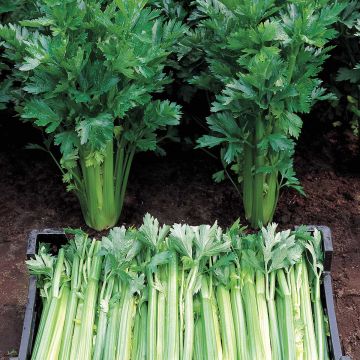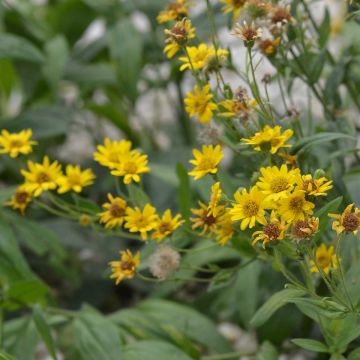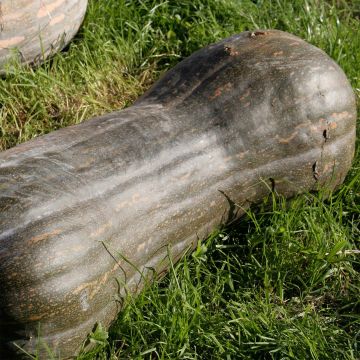

Martine Celery - Apium graveolens
Martine Celery - Apium graveolens
Apium graveolens Martine
Celery
Special offer!
Receive a €20 voucher for any order over €90 (excluding delivery costs, credit notes, and plastic-free options)!
1- Add your favorite plants to your cart.
2- Once you have reached €90, confirm your order (you can even choose the delivery date!).
3- As soon as your order is shipped, you will receive an email containing your voucher code, valid for 3 months (90 days).
Your voucher is unique and can only be used once, for any order with a minimum value of €20, excluding delivery costs.
Can be combined with other current offers, non-divisible and non-refundable.
Why not try an alternative variety in stock?
View all →This plant carries a 6 months recovery warranty
More information
We guarantee the quality of our plants for a full growing cycle, and will replace at our expense any plant that fails to recover under normal climatic and planting conditions.
Description
The Celery 'Martine' is a herbaceous vegetable plant cultivated for its highly aromatic petioles and leaves. Its red stalks distinguish it. The foliage is compact and vigorous, with pale green leaves with golden reflections. It has wide, fleshy stalks (petioles) shaped like gutters. The sowing period extends from February to the end of May for a harvest of 6 to 7 months after sowing.
Celery is a descendant of a plant called Marsh Ache, native to the Mediterranean. This plant was not considered a vegetable but a medicinal plant until the Renaissance.
Celery leaves are used as a condiment in soups and stews and to flavour certain sauces and stuffings. The raw, tender, finely sliced stalks can be part of the ingredients in compound salads. Celery has many virtues: anti-rheumatic, delicious, digestive, and remineralising, and contains vitamins and copper, iron, and iodine.
Celery will require a significant supply of well-decomposed compost or manure (5 kg per m²) as well as potash in the form, for example, of wood ash.
Harvest: Celery is harvested by cutting the whole plant at ground level as needed. This celery is sensitive to frost.
Storage: Before the frosts, from the end of October, the plants are pulled up with their roots and placed in trenches or stored in a cellar in the sand.
The gardener's tip: Celery is particularly demanding in water and nutrients. Provide a good mulch to maintain moisture at the base of the plant and a good supply of organic matter.
Harvest
Plant habit
Foliage
Botanical data
Apium
graveolens
Martine
Apiaceae
Celery
Cultivar or hybrid
Biennial
Other Celery seeds
View all →Planting and care
Sowing
from February to April
Seeds can be sown on a warm bed, in trays, in a greenhouse, or in a bright, heated room.
From mid-April to the end of May.
Seeds can be sown in a well-exposed location.
The soil or compost must be constantly moist, and the sowing can be covered with several layers of wet newspaper until germination. The growth is very slow at the beginning. The temperature should be above 15°C (59°F). Germination occurs within 12 to 15 days.
Before transplanting, usually in May-June, transplant the young plants once in a nursery when they have three leaves. Space them 5 to 10 cm (2 to 4in) apart in all directions. Take care to remove the tips of the rootlets and the main root. When planting, space them 35 cm (14in) apart in all directions.
Maintenance
It is essential to hoe and weed regularly to prevent diseases that attack celery, such as mildew or rust. Preventive treatment with a fungicide is effective against fungal diseases.
Watering should be abundant and frequent. A vegetative cover of the soil is beneficial.
Remember to practice a good crop rotation every 3 to 4 years.
Seedlings
Care
Intended location
Planting & care advice
This item has not been reviewed yet - be the first to leave a review about it.
Similar products
Haven't found what you were looking for?
Hardiness is the lowest winter temperature a plant can endure without suffering serious damage or even dying. However, hardiness is affected by location (a sheltered area, such as a patio), protection (winter cover) and soil type (hardiness is improved by well-drained soil).

Photo Sharing Terms & Conditions
In order to encourage gardeners to interact and share their experiences, Promesse de fleurs offers various media enabling content to be uploaded onto its Site - in particular via the ‘Photo sharing’ module.
The User agrees to refrain from:
- Posting any content that is illegal, prejudicial, insulting, racist, inciteful to hatred, revisionist, contrary to public decency, that infringes on privacy or on the privacy rights of third parties, in particular the publicity rights of persons and goods, intellectual property rights, or the right to privacy.
- Submitting content on behalf of a third party;
- Impersonate the identity of a third party and/or publish any personal information about a third party;
In general, the User undertakes to refrain from any unethical behaviour.
All Content (in particular text, comments, files, images, photos, videos, creative works, etc.), which may be subject to property or intellectual property rights, image or other private rights, shall remain the property of the User, subject to the limited rights granted by the terms of the licence granted by Promesse de fleurs as stated below. Users are at liberty to publish or not to publish such Content on the Site, notably via the ‘Photo Sharing’ facility, and accept that this Content shall be made public and freely accessible, notably on the Internet.
Users further acknowledge, undertake to have ,and guarantee that they hold all necessary rights and permissions to publish such material on the Site, in particular with regard to the legislation in force pertaining to any privacy, property, intellectual property, image, or contractual rights, or rights of any other nature. By publishing such Content on the Site, Users acknowledge accepting full liability as publishers of the Content within the meaning of the law, and grant Promesse de fleurs, free of charge, an inclusive, worldwide licence for the said Content for the entire duration of its publication, including all reproduction, representation, up/downloading, displaying, performing, transmission, and storage rights.
Users also grant permission for their name to be linked to the Content and accept that this link may not always be made available.
By engaging in posting material, Users consent to their Content becoming automatically accessible on the Internet, in particular on other sites and/or blogs and/or web pages of the Promesse de fleurs site, including in particular social pages and the Promesse de fleurs catalogue.
Users may secure the removal of entrusted content free of charge by issuing a simple request via our contact form.
The flowering period indicated on our website applies to countries and regions located in USDA zone 8 (France, the United Kingdom, Ireland, the Netherlands, etc.)
It will vary according to where you live:
- In zones 9 to 10 (Italy, Spain, Greece, etc.), flowering will occur about 2 to 4 weeks earlier.
- In zones 6 to 7 (Germany, Poland, Slovenia, and lower mountainous regions), flowering will be delayed by 2 to 3 weeks.
- In zone 5 (Central Europe, Scandinavia), blooming will be delayed by 3 to 5 weeks.
In temperate climates, pruning of spring-flowering shrubs (forsythia, spireas, etc.) should be done just after flowering.
Pruning of summer-flowering shrubs (Indian Lilac, Perovskia, etc.) can be done in winter or spring.
In cold regions as well as with frost-sensitive plants, avoid pruning too early when severe frosts may still occur.
The planting period indicated on our website applies to countries and regions located in USDA zone 8 (France, United Kingdom, Ireland, Netherlands).
It will vary according to where you live:
- In Mediterranean zones (Marseille, Madrid, Milan, etc.), autumn and winter are the best planting periods.
- In continental zones (Strasbourg, Munich, Vienna, etc.), delay planting by 2 to 3 weeks in spring and bring it forward by 2 to 4 weeks in autumn.
- In mountainous regions (the Alps, Pyrenees, Carpathians, etc.), it is best to plant in late spring (May-June) or late summer (August-September).
The harvesting period indicated on our website applies to countries and regions in USDA zone 8 (France, England, Ireland, the Netherlands).
In colder areas (Scandinavia, Poland, Austria...) fruit and vegetable harvests are likely to be delayed by 3-4 weeks.
In warmer areas (Italy, Spain, Greece, etc.), harvesting will probably take place earlier, depending on weather conditions.
The sowing periods indicated on our website apply to countries and regions within USDA Zone 8 (France, UK, Ireland, Netherlands).
In colder areas (Scandinavia, Poland, Austria...), delay any outdoor sowing by 3-4 weeks, or sow under glass.
In warmer climes (Italy, Spain, Greece, etc.), bring outdoor sowing forward by a few weeks.



























































